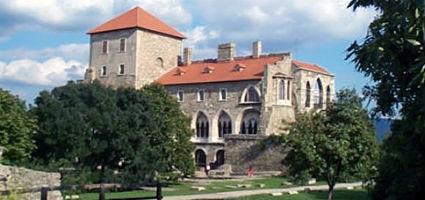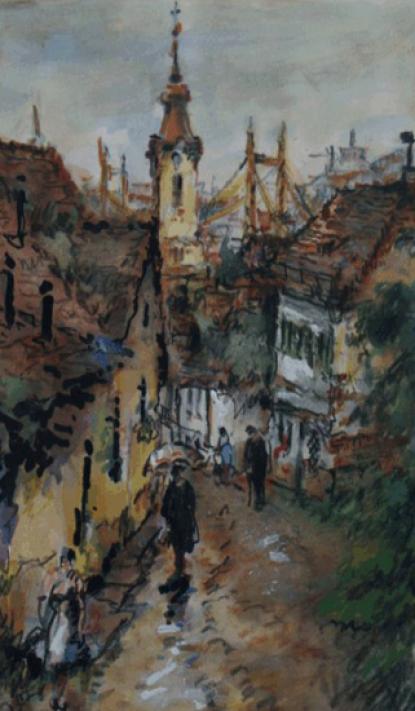2025. April 24. Thursday
Kuny Domokos Museum - Tata
 |
Address: 2890, Tata Váralja u. 1-3.
Phone number: (34) 381-251, (34) 381-251
E-mail: info@kunymuzeum.hu
Opening hours: K-V 9-18
|
The exhibition has closed for visitors.
2005.10.28. - 2006.03.31.
Museum tickets, service costs:
|
Group ticket
|
650 HUF
|
/ capita
|
|
Ticket for adults
|
800 HUF
|
/ capita
|
|
Ticket for students
|
400 HUF
|
/ capita
|
|
Ticket for pensioners
|
400 HUF
|
/ capita
|
|
Ticket for families
(2 adults + 2 children)
|
1500 HUF
|
/ family
|
|
Individual combined ticket for adults
|
1200 HUF
|
|
|
Individual combined ticket for students
|
600 HUF
|
|
|
Individual combined ticket for pensioners
|
600 HUF
|
|
|
Group guide
(up to 10 people)
|
1500 HUF
|
|
|
Group guide
(11-30 people)
|
3000 HUF
|
|
|
Group guide
(31-40 people)
|
4500 HUF
|
|
|
Photography
|
1500 HUF
|
|
|
Video
|
1500 HUF
|
|
|
Wedding photographs
|
10000 HUF
|
'I was born in Verbót in Nyitra County in 1887. My father introduced me to photography... I myself started to be interested in photography at age ten. I faithfully escorted my father on his journeys; I copied him and was his model many times.'

Vydareny Iván attended Secondary School, Evangelic Licee, in Bratislava where he regularly took photos and dealt with other genres of fine art as well. In 1907, he moved to Pest to study at the Arts University. After he graduated as an architect, he began to work at the Wellisch Alfréd Design Studio. His talent can still be observed on houses in Budapest.
In the war, he served as a company commander at first at the Russian front, later at the Italian front. He took uncountable number of photos of the destruction, but the horror did not fade his talent. Besides the photos taken at the front, he painted and drew nature. Similar to Vydareny, many artists took part in the war as war painters. Their woks made at the front were used as war propaganda.
He took fancy to painting from the painter Rauscher Lajos and Székely Árpád, Székely Bertalan's son. He met the baron Mednyánszky László in the war. Mednyánszky also did war paintings. 'In 1916 I was at the Russian Front when the adjutant took an interesting old man to the camp. The commanders entrusted me to take care of him. The old man was Mednyánszky László, the excellent Hungarian painter. I moved him to my barrack and he stayed for a few months'. The time they spent together was spent with lots of conversations so the young artist could learn of Mednyánszky's work method, artistic intentions, personality that influenced him greatly. Parallel with taking photos, Vydareny did pastels, aquarelles, oil paintings, and draw with pencil and coal. These works are just as valuable as his photos.
The exhibition of aquarelle and pastel painters opened in the National Salon in 1919. There Vydareny Iván presented his ornament-like landscapes. Still, the promising beginning had no extension. Why? Nobody knows. After the exhibition in 1919, he never showed his works again.
Vydareny Iván was an accepted photo artist but we know little of his paintings.
The exhibition was organized in memory of the painter Vydareny Iván. The paintings we show are only a small fragment of the oeuvre containing a few thousand pieces.
The selection gives an overview of the life-work of the artist. The pictures we show are the most important ones in the oeuvre of Vydareny Iván. At the beginning he worked in Verbót, Later he painted the events of the war, Budapest, the lifestyle in the country and the years he spent in Göd.

Vydareny Iván attended Secondary School, Evangelic Licee, in Bratislava where he regularly took photos and dealt with other genres of fine art as well. In 1907, he moved to Pest to study at the Arts University. After he graduated as an architect, he began to work at the Wellisch Alfréd Design Studio. His talent can still be observed on houses in Budapest.
In the war, he served as a company commander at first at the Russian front, later at the Italian front. He took uncountable number of photos of the destruction, but the horror did not fade his talent. Besides the photos taken at the front, he painted and drew nature. Similar to Vydareny, many artists took part in the war as war painters. Their woks made at the front were used as war propaganda.
He took fancy to painting from the painter Rauscher Lajos and Székely Árpád, Székely Bertalan's son. He met the baron Mednyánszky László in the war. Mednyánszky also did war paintings. 'In 1916 I was at the Russian Front when the adjutant took an interesting old man to the camp. The commanders entrusted me to take care of him. The old man was Mednyánszky László, the excellent Hungarian painter. I moved him to my barrack and he stayed for a few months'. The time they spent together was spent with lots of conversations so the young artist could learn of Mednyánszky's work method, artistic intentions, personality that influenced him greatly. Parallel with taking photos, Vydareny did pastels, aquarelles, oil paintings, and draw with pencil and coal. These works are just as valuable as his photos.
The exhibition of aquarelle and pastel painters opened in the National Salon in 1919. There Vydareny Iván presented his ornament-like landscapes. Still, the promising beginning had no extension. Why? Nobody knows. After the exhibition in 1919, he never showed his works again.
Vydareny Iván was an accepted photo artist but we know little of his paintings.
The exhibition was organized in memory of the painter Vydareny Iván. The paintings we show are only a small fragment of the oeuvre containing a few thousand pieces.
The selection gives an overview of the life-work of the artist. The pictures we show are the most important ones in the oeuvre of Vydareny Iván. At the beginning he worked in Verbót, Later he painted the events of the war, Budapest, the lifestyle in the country and the years he spent in Göd.
